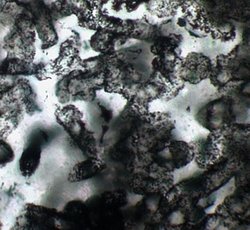“A collection of tubular microfossils found in 3.4-billion-year-old sandstone from Western Australia.” Source of caption and photo: online version of the NYT article quoted and cited below.
(p. A1) A team of Australian and British geologists have discovered fossilized, single-cell organisms that are 3.4 billion years old and that the scientists say are the oldest known fossils on earth.
Their assertion, if sustained, confirms the view that life evolved on earth surprisingly soon after the Late Heavy Bombardment, a reign of destruction in which waves of asteroids slammed into the primitive planet, heating the surface to molten rock and boiling the oceans into an incandescent mist. The bombardment, which ended around 3.85 billion years ago, would have sterilized the earth’s surface of any incipient life.
The claim is also a new volley in a long-running conflict over who has found the oldest fossil.
The new microfossils are described in Sunday’s issue of Nature Geoscience by a team led by David Wacey of the University of Western Australia and Martin D. Brasier of the University of Oxford. The fossils were found in sandstone at the base of the Strelley Pool rock formation in Western Australia.
The sandstone, 3.4 billion years ago, was a beach on one of the few islands that had started to (p. A3) appear above the ocean’s surface. Conditions were very different from those of today. The moon orbited far closer to earth, raising huge tides. The atmosphere was full of methane, since plants had not yet evolved to provide oxygen, and greenhouse warming from the methane had heated the oceans to the temperature of a hot bath.
It was in these conditions, the geologists believe, that organisms resembling today’s bacteria lived in the crevices between the pebbles on the beach. Examining thin slices of rock under the microscope, they have found structures that look like living cells, some in clusters that seem to show cell division.
Cell-like structures in ancient rocks can be deceiving — many have turned out to be artifacts formed by nonbiological processes. In this case, the geologists have gathered considerable circumstantial evidence that the structures they see are biological. With an advanced new technique, they have analyzed the composition of very small spots within the cell-like structures. “We can see carbon, sulfur, nitrogen and phosphorus, all within the cell walls,” Dr. Brasier said.
For the full story, see:
NICHOLAS WADE. “Team Claims It Has Found Oldest Fossils.” The New York Times (Mon., August 22, 2011): A1 & A3.
(Note: the online version of the article has the date August 21, 2011.)


